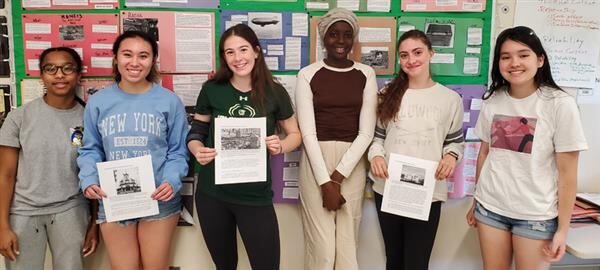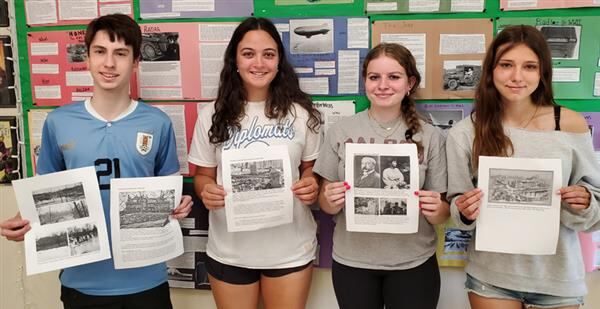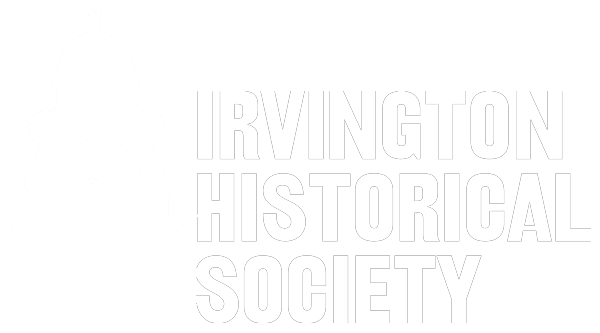Irvington High School Juniors Find Their Place in Local History
by The Irvington Historical Society
A group of Irvington High School juniors from Dr. Erik Weiselberg’s U.S. History classes researched various sites around Irvington and Tarrytown to make connections to their history lessons. Having explored a unit on Industrialization and Urbanization (1870-1920) – a time when many notable figures had homes or connections to places in or around Irvington – the students selected a site within the Irvington Union Free School District and researched the history behind it.
Curious about the stone walls, grand mansions and lingering ruins left from bygone days, the students explored source materials collected and curated by Dr. Weiselberg, as well as other readily available online sources.
“The project emphasized the students’ personal engagement with the people and places of Irvington’s past,” Dr. Weiselberg said.

Nafisa Diop researched the history of the Lord & Burnham Building, built in 1881, in which the company constructed greenhouses for wealthy estates nearby, including Lyndhurst.
“I learned to appreciate the creations of others for public display,” Diop said. “Lord & Burnham created beautiful greenhouses that we can still visit and appreciate today.”
Sophia Salvatore researched the history of the Cosmopolitan Building, designed by architect Stanford White and built in 1896 by magazine owner John Brisben Walker, who saw Irvington as an antidote to the difficulties of urban workers living in unhealthy conditions.
“I found it interesting to learn more about how these buildings impacted many people that were living in the city,” Salvatore said. “Irvington’s better living conditions appealed to a lot of people, then and now.”

Mika Hughes and Alexandra Lyashenko did their research on The Octagon House, originally built in 1858 by Paul Armour based on Orson Squire Fowler’s ideas about alleged health benefits of octagon-shaped houses, and in 1872 expanded by tea merchant Joseph Stiner to include a veranda and dome.
“This assignment gave me the opportunity to research and learn about this place that I live so close to yet, ironically, knew nothing about,” Lyashenko said.
Hughes reflected on the importance of history.
“It allows us to see how people who lived centuries ago lived, and to see how far we have come as a society,” Hughes said. “Fowler, whose ideas for octagon-shaped houses inspired many house designs, was a phrenologist, which was a very early attempt at psychology by interpreting the shape of a person’s head, something now looked upon as unscientific.”
Lavi Ben-Ari researched Quarry Hill, a former mansion built in 1894 at what is now Deertrack Lane in East Irvington and which was known through the 1950s as the Borg Estate, for Sidney Cecil Borg, a New York banker, and his wife, Madeleine Beer Borg, a philanthropist and activist. Ben-Ari used maps and newspaper accounts to trace the history of the artificial pond on the property, which was often used by the community for ice skating.
“This project had me very excited, because I had always wanted to learn about the history of the pond, but I did not know how to do that until now,” Ben-Ari said. “In fact, I thought there would be no history, because of how out of the way it is: a small street in a small town.”
Other sites that the students researched included Halsey Pond Park by Emma O’Donnell, the home of golfing pioneer C.C. Worthington by Jonah Grunstein, the original Ardsley Country Club by Drew Krzemienski, the Hermit’s Grave by Alyson Raimondo and Ella Weiss, and Madam C.J. Walker’s Villa Lewaro by Mags Ho Tai and Aniya Walker.
Weiss drew important lessons from the experience, reflecting on the importance of understanding local history.
“It gives you an idea of where you’re standing and of the thousands of important people who have lived in the same place you are right now,” she said.
Many of the larger properties from the Industrial Age eventually became garden apartments or other residential housing, and two of the estates became schools – Dows Lane Elementary School and Irvington High School.
“How fitting for students exploring the history of previous estates [that they] did so on the very locations of those former structures,” Dr. Weiselberg said.
Some of the students’ reports will be published in the Irvington Historical Society’s newsletter, The Roost, and distributed to over 400 society members.
